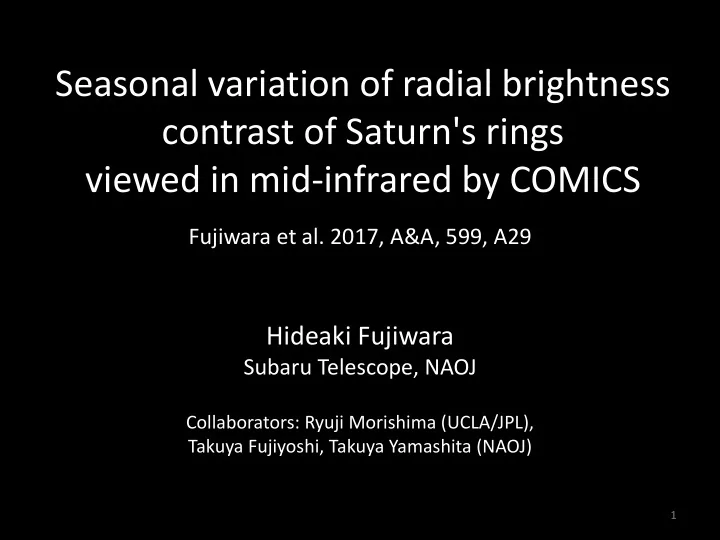

Seasonal variation of radial brightness contrast of Saturn's rings viewed in mid-infrared by COMICS Fujiwara et al. 2017, A&A, 599, A29 Hideaki Fujiwara Subaru Telescope, NAOJ Collaborators: Ryuji Morishima (UCLA/JPL), Takuya Fujiyoshi, Takuya Yamashita (NAOJ) 1
Planetary Rings: Miniature of dusty debris disks? • Disk structure by solid particles • Gas-free or gas-less system • Probably generated by collisions Saturn’s rings Debris Disk HR 4796A (Thalmann+ 2011) 2
A ring ( t ~0.5) Saturn’s Rings Cassini C ring Division ( t ~0.1) ( t ~0.1) B ring ( t ~1—5) Made from Icy Particles • • In visible light: sun light reflected on ring particles Optically thick A & B rings much brighter; optically thin C ring & • Cassini Division fainter How the rings look in thermal emission? • (c) NASA 3
Data • MIR Camera COMICS on Subaru Telescope with 8.2 m Primary Mirror on Maunakea • Multi-wavelength Imaging at 8.8, 9.7, 10.5, 11.7, 12.5, 17.7, 18.8, 20.5, 24.5 µ m Subaru Telescope • Observed in 2008/1/23 by G. Orton, L. Fletcher et al. (unpublished) • Almost edge-on rings to observer/Sun Astrometrical parameters COMICS Phase Ang. Sun-Saturn Solar El. (above ring plane) Earth-Saturn Earth El. 4
Ring Brightness Spatial Res: 0.38-0.67” = a few 1000 km ( Highest-ever in MIR from ground ) 8.8 µ m 9.7 µ m 10.5 µ m 12.5 µ m 11.7 µ m 17.7 µ m 20.5 µ m 18.8 µ m 24.5 µ m 5
Comparison w/ visible image MIR 24.5 µ m Visible (2008/01) Cassini C Cassini C (2008/03) Div. Div. A B A B Subaru Telescope Ishigakijima Obs. • Compared with visible image by Ishigakijima Obs. • C ring and Cassini Div. are brighter than B and A rings in MIR while C rings and Cassini Div. are always fainter in visible • Ring brightness contrasts in MIR and visible are reversed 6
12.5 18.8 24.5 µ m SEDs of Rings • Blackbody peaking at > 25 µ m • No significant dust features Reg. # Reg. 0 (A Ring East) Reg. 1 (B ring East) Reg. 2 (CD East) Reg. 3 (C ring East) T = 78 K T = 91 K T = 82 K T = 97 K Surface Brightness (Jy arcsec -2 ) Reg. 4 (C ring West) Reg. 5 (B ring West) Reg. 6 (CD West) Reg. 7 (A ring West) T = 100 K T = 84 K T = 93 K T = 80 K 10 20 10 20 10 20 10 20 7 Wavelength ( µ m)
Ring Temperatures • SED fit w/ BB (assuming t , measured from stellar occultation) → Physical Temperature of Ring Particles – Brightness I n ( l ) = b B n ( l ,T) – �������������� b = 1 - exp (- t /|sin B|) East Morning Evening West • C ring & Cassini Div. warmer than B, A rings • West side warmer than east side in each ring 8
Discussion 1. In the MIR, optically thin C ring and Cassini Div. were brighter than optically thick A & B rings in 2008 2. Temperatures in C ring and Cassini Div. were higher than A & B rings 3. West side is generally warmer than the east over the rings Accounted for by eclipse cooling in Saturn's shadow (E=morning, W=evening) – 2008 ( l =24.5 µ m) CD C B A • (1) & (2) related to each other Surface Brightness in Thermal Emission: I n ( l ) = b B n ( l ,T) • Filling factors in C ring and CD were lower than A & B rings • • BUT, effect of higher temperatures in C & CD overcome lower filling factors 9
Variation from 2005 to 2008 Compared with data in 2005 April, • 2008 ( l =24.5 µ m) Cassini C when ring opening was larger Div. (above ring plane) B A Solar El. Earth El. 2005 ( l =24.5 µ m) Contrast reversed in 2005-2008 • Cassini C Div. Could be explained by change in • filling factors Larger opening angle makes larger • A B contrast in optical depths C ring & CD fainter • (See Fujiwara et al. 2017 A&A for quantitative discussion) 10
Temporal Variation in Filling Factors Particle Filling Factors 2008 ( l =24.5 µ m) CD C Particle Filling Factor 1 1 0.5 0.5 0 0 70000 70000 80000 80000 90000 90000 100000 100000 110000 110000 120000 120000 130000 130000 140000 140000 A B Radius (km) B’ ~ -9 deg C ring B ring CD A ring 2005 ( l =24.5 µ m) CD C Particle Filling Factor 1 1 0.5 0.5 0 0 70000 70000 80000 80000 90000 90000 100000 100000 110000 110000 120000 120000 130000 130000 140000 140000 B A Radius (km) B’ ~ -22 deg • Larger ring opening angle makes larger contrast in filling factor 11
Summery • MIR image of Saturn from Subaru/COMICS • Measurement of Ring Brightness & Temperatures (Highest- ever spatial resolution from the ground) – C ring and Cassini Div. were warmer than B and A rings • In 2008 C ring and Cassini Div. were brighter than B and A rings (opposite contrast to visible light) • MIR Brightness Contrast became inverse from 2005 to 2008 • Observed temporal variation in the MIR brightness contrast is interpreted as a result of a seasonal effect with changing elevations of the Sun and observer above the ring plane 12
Recommend
More recommend